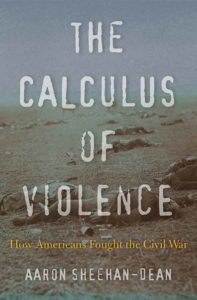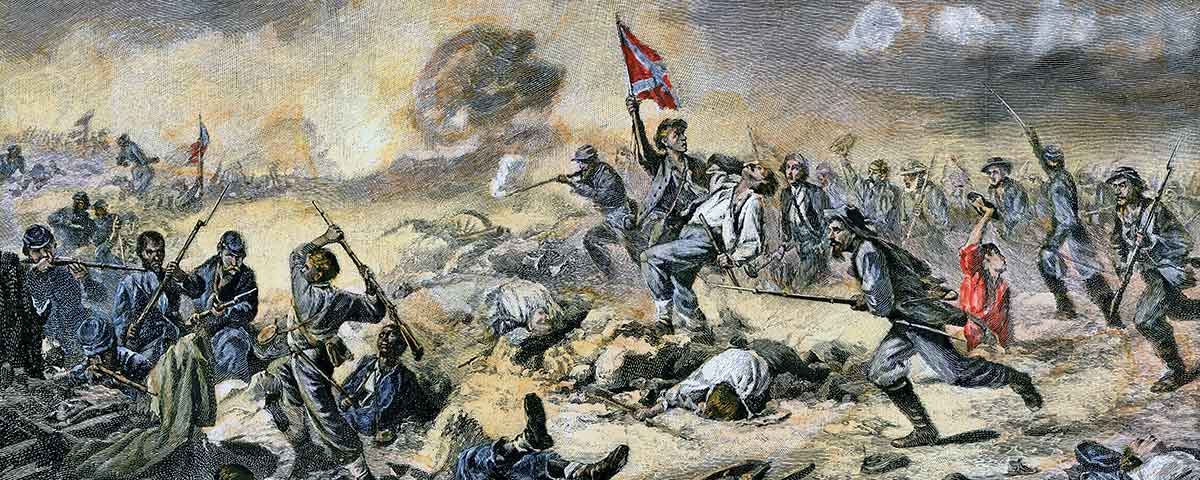Guerrilla raids and massacres of innocents were condemned as violations of the rules of war
The Civil War, which cost roughly 750,000 lives, including more than 200,000 battlefield deaths, remains America’s deadliest conflict and is considered history’s first “total war.” In The Calculus of Violence: How Americans Fought the Civil War (Harvard, 2018), Aaron Sheehan-Dean, Fred C. Frey professor of Southern Studies at Louisiana State University, argues that it could have been much worse, if both sides had not aspired to fight a just war.
[dropcap]1[/dropcap] Where did the Just War doctrine come from and what does it mean?

European historians would say it starts with theologians such as St. Augustine trying to reconcile war with Christian ethics. Seventeenth-century Dutch jurist Hugo Grotius argued that nations can wage war justly only by keeping violence within the bounds of Christian morality. Grotius influenced 18th-century writer Emer de Vattel, who was read by George Washington and Thomas Jefferson. The Revolutionary War generation was conversant with these theories, most importantly that violence should be aimed only at soldiers in uniform, not civilians.
[dropcap]2[/dropcap] Talk about Francis Lieber and the Lieber Code.
Francis Lieber was a German immigrant who taught at Columbia College and became a consultant to the Union Army. In 1863, he wrote what has become known as General Orders No. 100, which translated his European predecessors’ arcane just war theories into 19th-century American practicalities. The orders he set for the Army’s use were bullet points—what you can and cannot do. These were the first rules of engagement.
[dropcap]3[/dropcap] What does the Lieber Code allow?
Standard tactics such as besieging cities, destroying fortifications, and bombarding factories making war materiél were allowed. Targeting civilians or destroying institutions such as hospitals, schools, and libraries was prohibited. Lethal violence was restricted to those people who were under arms.
[dropcap]4[/dropcap] Did the opposing armies violate the laws of war?
Many Confederates regarded the Emancipation Proclamation and enlistment of black soldiers as violations of the laws of war because they supposedly encouraged servile insurrection on the home front. The Confederate leadership believed that black soldiers were not protected by the rules governing treatment of prisoners. Jefferson Davis believed that if former slaves were captured, they should be reenslaved or executed under state laws that imposed the death penalty for slave uprisings. Many black soldiers were killed trying to surrender. In July 1863, Abraham Lincoln issued a proclamation in which he said that for each Union soldier unjustly enslaved or executed after surrender, Union commanders would take a corresponding action against a captive Confederate. Lincoln was threatening to escalate the war dramatically; he put enough pressure on the South that at least some black soldiers were treated like whites.
[dropcap]5[/dropcap] But unjust killings continued, right?
At any moment, a division or even a brigade commander had considerable autonomy. At the Battle of the Crater at Petersburg in 1864, Confederate Brig. Gen. William Mahone famously sanctioned the killing of hundreds of wounded black men.
[dropcap]6[/dropcap] Did the North perceive the actions of Southern guerrillas as a violation?

On this, Lieber gives no wiggle room whatsoever. His code articulates a variety of ways of identifying guerrillas—men who don’t wear uniforms, or operate under the regular command of officers, don’t live in an army camp, and commit hit-and-run attacks. Those men, Lieber said, are to be considered highwaymen and summarily executed. There is no reliable count, but my guess is that thousands of guerrillas were executed, but thousands more were captured and sent to Northern prisons. It depended on the conditions. If men were captured with guns and horses but were not in the midst of committing an attack, they might be sent to prison. If they were caught in the act of or just after killing a Union sentry, they were probably executed because what they had done was considered murder.
[dropcap]7[/dropcap] How did the contrabands and freed people keep the war from getting worse than it was?
This is a fascinating yet little explored part of the story of emancipation. The enslaved who left plantations pursued freedom rather than revenge. In hindsight, it’s possible to see how people held in bondage who get an opportunity for retaliation could have taken the chance. The people freed during the Civil War didn’t do so, in part because they were starving, weak, and had no weapons. But there was also a religious dimension. The prophesies of Jubilee central to Afro-Christianity called on people to liberate themselves but did not justify perpetuating the violence rife in slavery itself. It seems that African Americans, both enslaved and free, clearly recognized that their goal was freedom, and defeating slavery was the military’s job.
[dropcap]8[/dropcap] In what ways did each side attempt to keep the war within bounds?
Both armies policed themselves. Soldiers were prosecuted for violating the laws of war. We have all Union court-martial records, but most of the Confederate records were destroyed when Richmond burned. Union soldiers were prosecuted for rape and the killing of noncombatants, and there’s a whole range of crimes under the heading of “conduct unbecoming” or “dereliction of duty.” There was also an extensive effort to communicate across the lines to complain to an opposing commander about alleged violations. These letters would usually threaten retaliation unless the actions were explained. Some of these parleys lasted for months and sometimes reached as high as Lincoln or Davis, allowing tempers to cool. Retaliatory executions were rare. That’s something distinct about how democracies fight. Civilians were aware that the armies were policing themselves. If there was no adequate explanation for a suspicious action, there was usually public condemnation.
[dropcap]9[/dropcap] How does the Just War doctrine explain the Lost Cause?
The Lost Cause is predicated on the belief that the North fought an unjust war. It’s part of popular myth that Sherman laid waste to the South and in doing so must have killed many civilians. In fact, we know he didn’t. At Atlanta, five weeks of around-the-clock shelling killed probably 20 civilians. Also, the Lost Cause sets up a clash between rapacious Yankees and Christian gentlemen like Lee who fought according to the laws of war, a decision that was noble but led to the South’s defeat.
[dropcap]10[/dropcap] Can any war be just?
It’s impossible to say that any war is fully just. I think that the armies of democracies are much more likely to behave justly. We see this today with the U.S. military. Today, as in the Civil War, there is a public feedback loop that helps keep things honest. The Army is us. It represents our values. It’s unpleasant to have to try individuals accused of violating the laws of war, but in general the U.S. Army adheres to a very high standard and has a very public accounting system. This is a dramatic difference from past generations and is certainly not the same in autocracies. If there is a just war in the future, it will be waged by a democracy with a watchful public.





